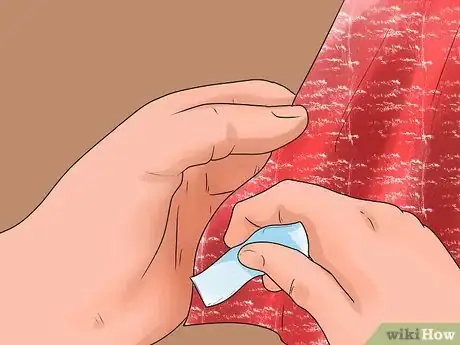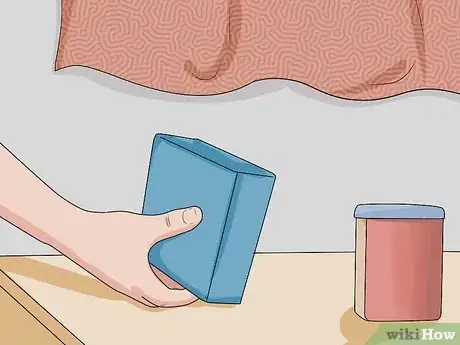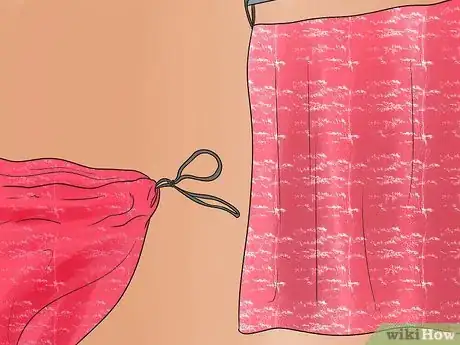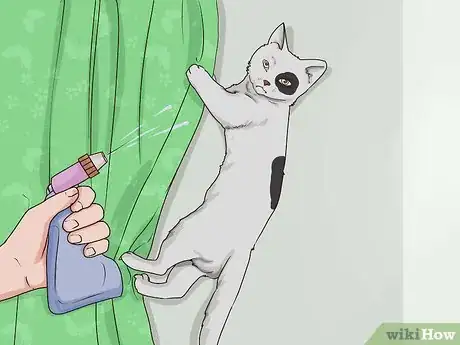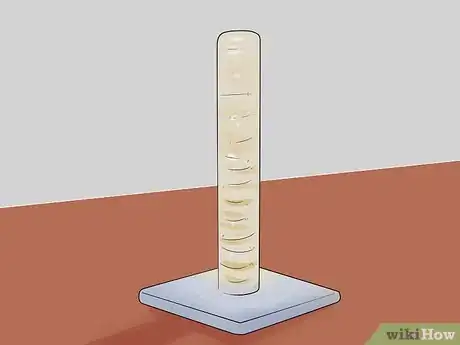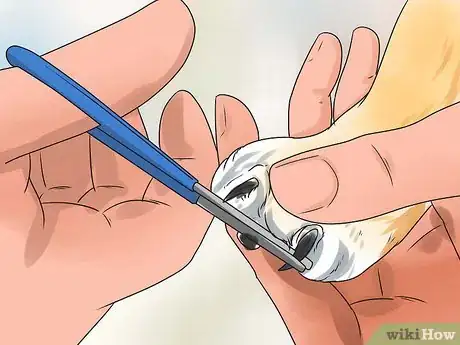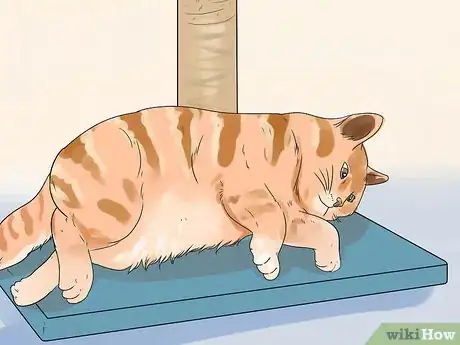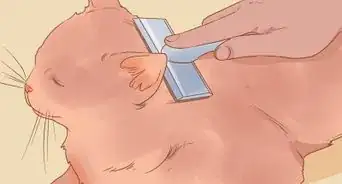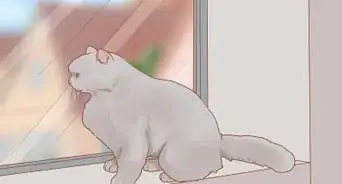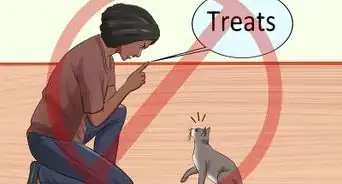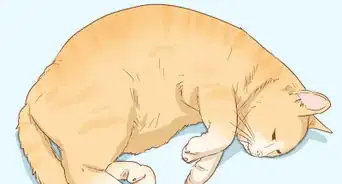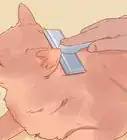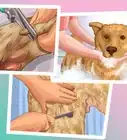This article was co-authored by Jessica Char. Jessica Char is a Cat and Dog Trainer, Behavior Consultant, and the Founder of Feline Engineering and Canine Engineering. She specializes in modifying challenging pet behavior problems, such as fear and aggression, using positive reinforcement training protocols. Jessica is a Certified Fear Free Trainer, a Certified Professional Dog Trainer, and a Certified Separation Anxiety Trainer. She is also a member of the International Association of Animal Behavior Consultants. Jessica received her BS and MS in Biomedical Engineering from Washington University in St. Louis.
This article has been viewed 115,703 times.
When curtains and cats meet, conflicts -- and claw snags -- are sure to arise. Fortunately, with proper training your cat and your draperies can successfully co-exist. Take a few minutes to consider why your cat might be climbing the curtains. You'll save time and effort on training if you start with some ideas about what might be prompting your cat's destructive activity. Then, turn your attention toward the various training ideas outlined below. Bear in mind that an effective solution will likely include both training your cat not to climb and addressing any needs the cat may be fulfilling for itself when it engages in this frustrating pastime.
Steps
Training Your Cat Not to Climb
-
1Invest in "environmental punishers." Environmental punishers are effective tools that aren't dependent upon your physical presence. These tools will enable you to safely send your cat a consistent message that the curtains are not a climbing toy.
-
2Purchase a compressed-air cat repellent system. These systems are equipped with a motion sensor. When your cat wanders too close to the curtains it will be met with a blast of compressed air.Advertisement
-
3Place plastic sheeting at the base of your curtains. Pet retailers sell a type of plastic sheeting that delivers a mild static charge when the cat steps upon the surface. In dry indoor environments any plastic may be sufficient to cause a minor static shock.
- You can also take the curtains down altogether. This breaks your cat's desire to climb since the curtains aren't readily available.[1]
-
4Trim your curtains with double-sided sticky tape. Cats are likely to find the texture unappealing. They may also find it difficult to penetrate with their claws. Test the tape in an unobtrusive location to ensure it will not mar your curtain fabric.
-
5Booby-trap any surfaces your cat might be climbing toward. If your cat appears to be climbing the curtains in order to reach a table top, counter, or shelf, place a stack of lightweight, easily toppled items such as plastic storage containers on the surface. Your cat will be startled when it knocks over a clattering pile of plastic, and may think twice about returning to its favorite haunt.[2] [3]
-
6Replace your curtain hooks with lightweight thread. When your cat tries to climb, it will break the thread and pull down the curtains. Once the cat has experienced this consequence a few times it is unlikely to persist, and the curtains can be re-hung properly.
- You may also try replacing existing window hardware with a tension rod if your curtains are hanging where use of one is feasible. Many adult cats are heavy enough to pull down the rod if they attempt to climb the attached curtains. Exercise care in using this solution, however, as you don't want the rod to break decorative items (or harm your cat) on the way down. [4]
-
7Use direct punishments as a last resort. Your cat may respond to clapping, spraying water, or rattling newspaper or a plastic grocery bag. Try other methods first, however, as direct punishment runs the risk of scaring your cat. These methods should not be employed if the cat is already skittish. If you choose to use water, test to make sure errant spray won't damage your curtains.
Addressing Your Cat's Needs
-
1Provide scratching posts.[5] These will meet your cat's instinctual need to sharpen its claws. If your curtains are made of heavy or highly textured cloth, what you see as decor might look like a delightful claw-sharpening surface to your cat.
- Different cats prefer different textures and styles; consider cardboard, carpeting, wood, sisal, or upholstery, and horizontal, vertical, or diagonal posts.
- Lure your cat toward the post with treats or catnip. You might even try "modelling" scratching behavior to illustrate the possibilities of this new contraption. Don't, however, force your cat's paws against the post. You might frighten your cat, leading it to avoid the scratching post altogether.
- Make sure posts are sturdy and of sufficient height, and don't toss them when they start to fray -- from a cat's perspective, a worn post offers perfect traction![6]
-
2
-
3Contemplate whether your cat needs something to do. Behavior you find infuriating may be your cat's solution to boredom. Cats left alone for long stretches of time may be especially prone to finding "creative" (and destructive) ways to occupy their time. Provide enrichment activities to keep your cat's mind and body sharp.[9]
- Hide cat treats around the house. Something as simple as an empty box perforated with small holes and containing kibble or cat treats can provide useful stimulation.
- Invest in cat toys. Toys that hang or swing are a particularly useful alternative to feline destruction of your curtain ties or tassels.
- Consider hanging bird feeders in a (curtain-free!) location where your cat can watch the activity outdoors.
- Provide a human-approved location such as a cat perch, accessible shelf, or other elevated surface where your cat can fulfill its natural climbing instincts and enjoy the view. [10] [11]
-
4Ensure your cat feels safe in its environment. Again, cats are natural climbers. If your cat feels threatened by other pets or small children, it may seek safety by escaping upward.
- Cat perches offer a human-approved escape route for anxious felines.
- Pet or child gates can ensure that your cat has access to safe zones in your home. Cats will simply jump over gates placed to stymie small dogs or toddlers. Stairways may be especially useful locations for such barriers -- cats enjoy watching the action below from the safety of a sheltered stair.
- Most home improvement retailers sell small cat doors designed for either exterior or interior use. Even indoor cats can benefit from a strategically placed door allowing access to a basement or storage room where they can escape when they feel threatened.
-
5Remove nearby houseplants or food sources.[12] These items may act as cat-magnets in ways that jeopardize both your cat's welfare and the well-being of your curtains.
- Check to make sure your houseplants are not poisonous to cats, and remove tempting hanging baskets or trailing flora from locations adjacent to drapes and curtains.
- Cover candy dishes, snacks, or other culinary temptations. Learn what your cat finds appealing -- each animal responds differently to "human" food.
Expert Q&A
-
QuestionWhy does my cat keep climbing on my curtains?
 Jessica CharJessica Char is a Cat and Dog Trainer, Behavior Consultant, and the Founder of Feline Engineering and Canine Engineering. She specializes in modifying challenging pet behavior problems, such as fear and aggression, using positive reinforcement training protocols. Jessica is a Certified Fear Free Trainer, a Certified Professional Dog Trainer, and a Certified Separation Anxiety Trainer. She is also a member of the International Association of Animal Behavior Consultants. Jessica received her BS and MS in Biomedical Engineering from Washington University in St. Louis.
Jessica CharJessica Char is a Cat and Dog Trainer, Behavior Consultant, and the Founder of Feline Engineering and Canine Engineering. She specializes in modifying challenging pet behavior problems, such as fear and aggression, using positive reinforcement training protocols. Jessica is a Certified Fear Free Trainer, a Certified Professional Dog Trainer, and a Certified Separation Anxiety Trainer. She is also a member of the International Association of Animal Behavior Consultants. Jessica received her BS and MS in Biomedical Engineering from Washington University in St. Louis.
Cat & Dog Behavior Consultant Well, your cat probably wants to go higher up to check out the environment or to play. He probably gets your attention when doing so, and that should motivate him to keep doing it.
Well, your cat probably wants to go higher up to check out the environment or to play. He probably gets your attention when doing so, and that should motivate him to keep doing it. -
QuestionHow do I get my cat to stop climbing the curtains?
 Jessica CharJessica Char is a Cat and Dog Trainer, Behavior Consultant, and the Founder of Feline Engineering and Canine Engineering. She specializes in modifying challenging pet behavior problems, such as fear and aggression, using positive reinforcement training protocols. Jessica is a Certified Fear Free Trainer, a Certified Professional Dog Trainer, and a Certified Separation Anxiety Trainer. She is also a member of the International Association of Animal Behavior Consultants. Jessica received her BS and MS in Biomedical Engineering from Washington University in St. Louis.
Jessica CharJessica Char is a Cat and Dog Trainer, Behavior Consultant, and the Founder of Feline Engineering and Canine Engineering. She specializes in modifying challenging pet behavior problems, such as fear and aggression, using positive reinforcement training protocols. Jessica is a Certified Fear Free Trainer, a Certified Professional Dog Trainer, and a Certified Separation Anxiety Trainer. She is also a member of the International Association of Animal Behavior Consultants. Jessica received her BS and MS in Biomedical Engineering from Washington University in St. Louis.
Cat & Dog Behavior Consultant First you need to understand what the cat is getting out of this behavior. If the cat is scratching the curtains, you probably need to give him an appropriate scratching place. If the cat is using the curtain to climb, provide a piece of furniture that lets him climb on.
First you need to understand what the cat is getting out of this behavior. If the cat is scratching the curtains, you probably need to give him an appropriate scratching place. If the cat is using the curtain to climb, provide a piece of furniture that lets him climb on. -
QuestionHow do I keep my cat off my high places?
 Jessica CharJessica Char is a Cat and Dog Trainer, Behavior Consultant, and the Founder of Feline Engineering and Canine Engineering. She specializes in modifying challenging pet behavior problems, such as fear and aggression, using positive reinforcement training protocols. Jessica is a Certified Fear Free Trainer, a Certified Professional Dog Trainer, and a Certified Separation Anxiety Trainer. She is also a member of the International Association of Animal Behavior Consultants. Jessica received her BS and MS in Biomedical Engineering from Washington University in St. Louis.
Jessica CharJessica Char is a Cat and Dog Trainer, Behavior Consultant, and the Founder of Feline Engineering and Canine Engineering. She specializes in modifying challenging pet behavior problems, such as fear and aggression, using positive reinforcement training protocols. Jessica is a Certified Fear Free Trainer, a Certified Professional Dog Trainer, and a Certified Separation Anxiety Trainer. She is also a member of the International Association of Animal Behavior Consultants. Jessica received her BS and MS in Biomedical Engineering from Washington University in St. Louis.
Cat & Dog Behavior Consultant Don't give him attention when he's climbing the curtains and try to create a little bit of discomfort for him. Make it more fun to sit on their appropriate spots and less comfortable to get up on the curtain.
Don't give him attention when he's climbing the curtains and try to create a little bit of discomfort for him. Make it more fun to sit on their appropriate spots and less comfortable to get up on the curtain.
Warnings
- While claw-sharpening may be your cat's motivation for attacking your curtains, refrain from de-clawing your cat. The de-clawing procedure involves amputating the end joint of a cat's toes and is quite painful to the cat. Tendonectomies are sometimes proposed as alternatives, preventing the cat from extending its claws to scratch, but they may or may not be less painful -- and afterward you'll need to clip your cat's nails regularly because it will no longer be able to maintain them on its own. Environmental and behavior modification are much better options for you and your cat.⧼thumbs_response⧽
References
- ↑ Rita Reimers. Cat Behaviorist. Expert Interview. 22 June 2021.
- ↑ www.aspca.org/pet-care/virtual-pet-behaviorist/cat-behavior/keeping-your-cat-countertops-and-tables
- ↑ www.aspca.org/pet-care/virtual-pet-behaviorist/cat-behavior/destructive-scratching
- ↑ www.fanciers.com/cat-faqs/behavior.shtml
- ↑ Jessica Char. Cat & Dog Behavior Consultant. Expert Interview. 28 September 2021.
- ↑ www.aspca.org/pet-care/virtual-pet-behaviorist/cat-behavior/destructive-scratching
- ↑ www.aspca.org/pet-care/virtual-pet-behaviorist/cat-behavior/destructive-scratching
- ↑ Rita Reimers. Cat Behaviorist. Expert Interview. 22 June 2021.
- ↑ Jessica Char. Cat & Dog Behavior Consultant. Expert Interview. 28 September 2021.
- ↑ http://www.thedailycat.com/behavior/behaviorproblems/are_mischievous_cats_just_bored/index.html#axzz3knMSuIp9
- ↑ http://www.thedailycat.com/behavior/behaviorproblems/are_mischievous_cats_just_bored/index.html#axzz3knMSuIp9
- ↑ Jessica Char. Cat & Dog Behavior Consultant. Expert Interview. 28 September 2021.




